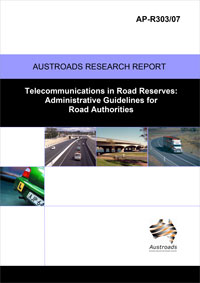Asset Management

Telecommunications in Road Reserves: Administrative Guidelines for Road Authorities
- Publication no: AP-R303-07
- ISBN: 978-1-921329-08-1
- Published: 20 April 2007
- PDF (free) Download
This document outlines the policy and procedures for access to road infrastructure by telecommunications Carriers, when using their powers under the Telecommunications Act 1997. It also provides advice to Road Authorities on commercial and other matters to be considered when negotiating agreements with Carriers for the installation of all types of telecommunications facilities in road reserves.
Reconfirmation
These Guidelines were reviewed and reconfirmed in 2012.
- CONTENTS
- PREFACE
- 1. INTRODUCTION
- 1.1. Goals
- 1.2. General principles
- 1.3. Legislation
- 1.4. Conflicts
- 1.5. About the Guidelines
- 2. CARRIER POWERS
- 2.1. Who are 'Carriers'?
- 2.2. What is a 'Nominated Carrier Declaration'?
- 2.3. What may Carriers do?
- 2.4. What are Carriers' obligations under the Act?
- 2.5. What may a Carrier do when installing a facility?
- 2.6. What may a Carrier do when maintaining facilities?
- 2.7. What may a Carrier do when inspecting land?
- 2.8. What if a Carrier enters land illegally?
- 3. ROAD AUTHORITY POWERS
- 3.1. Works involving low impact facilities
- 3.2. Works involving other than low impact facilities
- 4. AGREEMENTS FOR LOW IMPACT FACILITIES
- 4.1. When must Carriers' make reasonable efforts to agree?
- 4.2. What does 'affect Road Authority operations' mean?
- 4.3. What must Carriers 'make reasonable efforts to agree'?
- 4.4. What conditions should be included in an agreement?
- 4.5. What is the basis for compensation?
- 4.6. What if there is no written agreement prior to Notice?
- 5. AGREEMENTS- MATTERS THAT MAY BE INCLUDED
- 5.1. Design and Installation of Facilities
- 5.2. Inspection and Maintenance of Facilities
- 5.3. Warranties
- 5.4. Indemnities
- 5.5. Insurance
- 5.6. Post-notification of Works
- 5.7. Damage to Facilities
- 5.8. Alteration of Facilities
- 5.9. Rental charges for telecommunications facilities in road reserves
- 5.10. Form of agreement
- 5.11. Cost recovery for administrative work associated with assessing installation proposals
- 6. NOTIFICATIONS
- 6.1. When should a Notice be received?
- 6.2. What if the notice period is insufficient?
- 6.3. When does a notice period expire?
- 6.4. What must the Notice contain?
- 6.5. What should be done after receiving a Notice?
- 7. OBJECTIONS
- 7.1. Can an objection be made to a Carrier activity?
- 7.2. When must an objection be lodged?
- 7.3. How is an objection lodged?
- 7.4. What happens when a Carrier receives an objection?
- 7.5. May the Carrier change its proposed activity?
- 7.6. What if the Carrier refuses to change its proposed activity?
- 7.7. What can the Ombudsman do?
- 8. INFORMATION ON THE LOCATION OF FACILITIES
- 8.1. Dial Before You Dig
- 8.2. Proving the location of underground facilities
- 8.3. Records of location
- 8.4. Marker posts
- 8.5. Remote sensing devices
- 9. EXISTING TELECOMMUNICATIONS FACILITIES
- 9.1. Compensation
- 9.2. Facilities installed prior to 1991
- 9.3. Removal of overhead telecommunications cables
- APPENDIX 1: FLOWCHARTS & CHECKLIST
- APPENDIX 2: STANDARD LETTERS (LOW IMPACT FACILITIES)
- APPENDIX 3: DEFINITIONS
- APPENDIX 4: CO-LOCATION PROCEDURE
- APPENDIX 5: OVERHEAD CABLES
Related publications
WEB-MSULR-20
Latest Asset Management News
